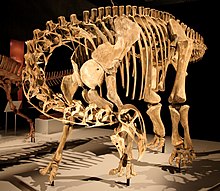
Back نيجرصور Arabic Нигерзавър Bulgarian নাইজারসরাস Bengali/Bangla Nigersaure Catalan Nigersaurus Czech Nigersaurus Danish Nigersaurus German Nigersaurus taqueti Spanish نیگرسور Persian Nigersaurus Finnish
| Nigersaurus Temporal range: Aptian – Albian
| |
|---|---|

| |
| Reconstructed skeleton in Japan | |
| Scientific classification | |
| Domain: | Eukaryota |
| Kingdom: | Animalia |
| Phylum: | Chordata |
| Clade: | Dinosauria |
| Clade: | Saurischia |
| Clade: | †Sauropodomorpha |
| Clade: | †Sauropoda |
| Superfamily: | †Diplodocoidea |
| Family: | †Rebbachisauridae |
| Genus: | †Nigersaurus Sereno et al., 1999 |
| Species: | †N. taqueti
|
| Binomial name | |
| †Nigersaurus taqueti Sereno et al., 1999
| |
Nigersaurus (/niːˈʒɛərsɔːrəs, ˈnaɪdʒərsɔːrəs/) is a genus of rebbachisaurid sauropod dinosaur that lived during the middle Cretaceous period, about 115 to 105 million years ago. It was discovered in the Elrhaz Formation in an area called Gadoufaoua, in Niger. Fossils of this dinosaur were first described in 1976, but it was only named Nigersaurus taqueti in 1999, after further and more complete remains were found and described. The genus name means "Niger reptile", and the specific name honours the palaeontologist Philippe Taquet, who discovered the first remains.
Small for a sauropod, Nigersaurus was about 9 m (30 ft) long, and had a short neck. It weighed around 1.9–4 t (2.1–4.4 short tons), comparable to a modern elephant. Its skull was very specialised for feeding, with large fenestrae and thin bones. It had a wide muzzle filled with more than 500 teeth, which were replaced at a rapid rate: around every 14 days. The jaws may have borne a keratinous sheath. Unlike other tetrapods, the tooth-bearing bones of its jaws were rotated transversely relative to the rest of the skull, so that all of its teeth were located far to the front. Its skeleton was highly pneumatised (filled with air spaces connected to air sacs), but the limbs were robustly built.
Nigersaurus and its closest relatives are grouped within the subfamily Rebbachisaurinae (formerly thought to be grouped in the eponymous Nigersaurinae) of the family Rebbachisauridae, which is part of the sauropod superfamily Diplodocoidea. Nigersaurus was probably a browser, and fed with its head close to the ground. The region of its brain that detected smell was underdeveloped, although its brain size was comparable to that of other dinosaurs. There has been debate on whether its head was habitually held downwards, or horizontally like other sauropods. It lived in a riparian habitat, and its diet probably consisted of soft plants, such as ferns, horsetails, and angiosperms. It is one of the most common fossil vertebrates found in the area, and shared its habitat with other dinosaurian megaherbivores, as well as large theropods and crocodylomorphs.
© MMXXIII Rich X Search. We shall prevail. All rights reserved. Rich X Search